Sumac onions are a quick and tangy traditional Middle Eastern condiment that adds a burst of citrusy flavor to grilled meats like shish kebab, shawarma, wraps, salads, and falafel. This Sumac Onions Recipe is the ultimate flavor booster, made with thinly sliced red onions, vibrant sumac, tart lemon juice, olive oil, and a pinch of salt.
Ready in just 10 minutes, this easy recipe with simple ingredients delivers a refreshing, citrusy kick, making it the perfect topping for your next mezze spread or any dish in need of a little zing.
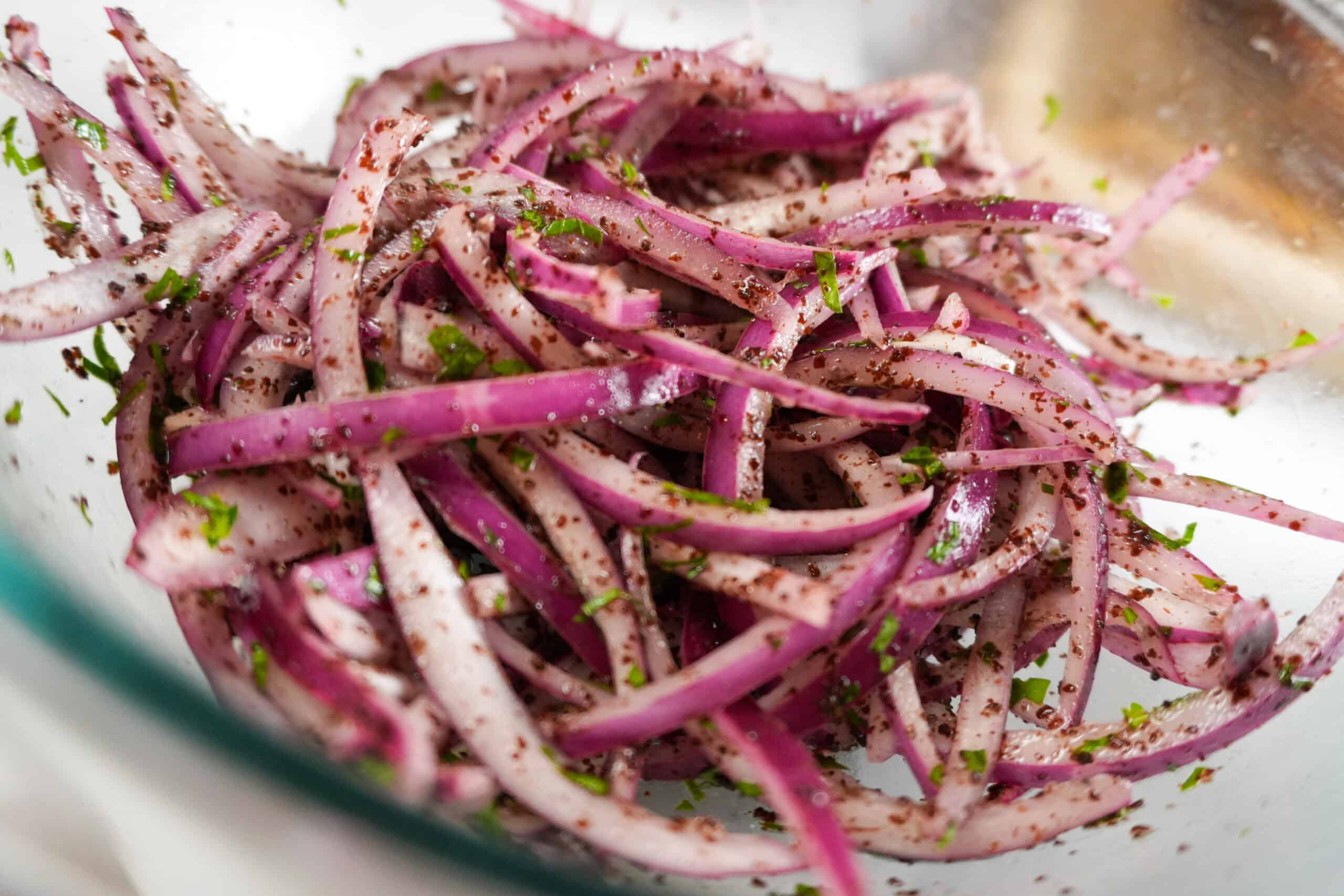
Table of Contents
Jump to:
- Why You Need This Middle Eastern Sumac Onions Recipe in Your Life
- What Are Sumac Onions?
- What Do Sumac Onions Taste Like?
- The Origin and History of Sumac Onions
- How Lebanon, Turkey, and Iran Make Theirs Unique
- Regional Variations of Sumac Onions
- How to Tell Them Apart?
- Why This Is So Cool
- How I Love Using This Sumac Onions Recipe
- Similar Condiments from Around the World
- Ingredients with Steps
- Culinary Glossary
- Instructions with Pictures
- Substitutions
- Variations
- Equipment
- Storage
- Cooking Tips
- Frequently Asked Questions
- Middle Eastern Recipes
- Side Dish Recipes
- 📖 Recipe
- Subscribe to the YouTube Channel
- Have a Comment or Question?
Why You Need This Middle Eastern Sumac Onions Recipe in Your Life
You know that moment when you take a bite of a perfectly seasoned shawarma wrap, and there’s that one ingredient that makes everything pop? Yep, that’s sumac-marinated red onions working their magic.
From building a mezze platter to upgrading your grilled meat game, this quick pickled sumac onions recipe will be your new go-to condiment. These beauties are a staple in Middle Eastern cuisine, adding a zippy, citrusy kick that cuts through rich meats and creamy sauces like a great cook.
What Are Sumac Onions?
At their core, sumac onions are a simple yet transformative mix of red onions, sumac powder, lemon juice (or white vinegar if you're out of lemons), a drizzle of olive oil, and a pinch of salt. If you're feeling fancy, a sprinkle of fresh parsley takes them to the next level of flavor.
The main ingredient here—sumac—is a deep red spice made from dried, ground berries that pack a punch of tangy, almost lemony flavor. Combined with onions, it softens their sharpness and turns them into an irresistible, flavor-packed topping.
What Do Sumac Onions Taste Like?
Imagine if red onions and lemon juice had a baby, but instead of being sharp and aggressive, that baby was well-balanced, slightly sweet, and full of personality. That’s Middle Eastern sumac onions for you!
They have a bold, tart kick from the sumac powder and lemon, a slight richness from the olive oil, and just enough salt to bring everything together. They taste like they belong on everything—grilled meats, falafel, wraps, salads, even straight out of the bowl (no judgment).
And if you're feeling experimental, throw them into a grain bowl or alongside roasted veggies for an instant upgrade.
The Origin and History of Sumac Onions
If you’ve ever dined in the Middle East, chances are you’ve met sumac-marinated red onions before. These zesty onions have been a beloved part of Levantine and Mediterranean cuisines for centuries.
Middle Eastern street vendors and home cooks alike use them to balance out rich, smoky flavors from grilled lamb, chicken, and beef. Historically, sumac was used as a souring agent before lemons were widely available, which explains why it’s still a staple in regional cooking today.
In places like Lebanon, Turkey, and Iran, you’ll find these onions nestled into everything from kebabs to pitas, adding a much-needed punch of acidity to a dish.

Looking for authentic Middle Eastern recipes? Check out Middle Eats and Amira's Pantry.
How Lebanon, Turkey, and Iran Make Theirs Unique
Did you know that Lebanon, Turkey, and Iran each have their own spin on sumac onions? While the base ingredients—raw red onion, sumac, lemon juice (or vinegar), olive oil, and salt—stay consistent, the way they prepare them varies, making it possible to taste the difference based on where they’re from.
Regional Variations of Sumac Onions
I think this is super cool because even something as simple as marinated onions can have regional flair. Let’s break it down and see how these countries make their sumac-marinated red onions their own.
Lebanese Sumac Onions – Fresh and Zesty
Lebanese-style sumac onions are all about light, bright, and fresh flavors. The onions are thinly sliced and massaged with lemon juice and sumac to soften them, making them milder while still packing that zesty punch.
Parsley is often added for an extra fresh note, and some versions even include a touch of garlic or a drizzle of pomegranate molasses for sweetness and depth. This style is perfect for shawarma, grilled meats like kafta, mezze platters, and falafel wraps.
The freshness of Lebanese sumac onions makes them stand out as a bold, citrusy contrast to rich dishes.

Looking for authentic Lebanese recipes? Check out Maureen Abood and Feel Good Foodie.
Turkish Onion Salad – Bold and Herbaceous
If you ever order an Adana kebab or a döner in Turkey, chances are you’ll get a side of soğan salatası—a deliciously tangy, herbaceous, and slightly spiced version of sumac onions. The key difference? The onions are rubbed with salt first, then rinsed to reduce their sharpness before being mixed with sumac and vinegar.
Turkish sumac onions often include dried mint and sometimes Aleppo pepper, adding a subtle earthiness and a touch of warmth. Some versions even feature pomegranate molasses for a delicate balance of tangy and sweet. These onions don’t just brighten up a dish—they make everything taste more complex and layered.

Looking for authentic Turkish recipes? Check out Foolproof Living and Vidar Bergum: A Kitchen in Istanbul.
Iranian Sumac Onions – Simple, Aromatic, and Earthy
Iranian sumac onions take a more minimalist approach, yet they still deliver on flavor. Unlike the Lebanese and Turkish versions, these onions are sometimes left drier, with just a sprinkle of sumac powder and salt to enhance their natural bite.
But here’s where it gets interesting—some Iranian variations use saffron-infused water, adding an incredible aroma and a hint of golden color. This version is often served alongside chelow kebab (Persian rice and kebabs), koobideh, and rich lamb dishes, balancing out the deep, smoky flavors with its subtle citrusy tang.
If you ever see sumac onions with a warm saffron hue, you’re likely enjoying an Iranian-style preparation.

Looking for authentic Iranian recipes? Check out Cooking with Ayeh and Persian Mama.
How to Tell Them Apart?
Now that we’ve covered the differences, here’s a cheat sheet on how to spot (and taste) them:
- Lebanese sumac onions are the freshest and zestiest, typically mixed with parsley and sometimes a touch of garlic or pomegranate molasses.
- Turkish sumac onions have dried mint or Aleppo pepper, and the onions are salt-rubbed first before being seasoned. Some versions include a hint of sweetness from pomegranate molasses.
- Iranian sumac onions are often drier and simpler, with sumac and salt as the primary seasonings. Some versions take it up a notch with saffron-infused water, giving them a subtle floral aroma.
Why This Is So Cool
I love how something as simple as onions and sumac can be so different across cultures! It’s proof that even the tiniest tweaks—whether it’s adding herbs, salt-rubbing the onions, or sneaking in saffron—can transform a dish and tell a story about the region it comes from.
Next time you’re enjoying a shawarma platter, kebab wrap, or mezze spread, see if you can tell which style of sumac onions you’re tasting. Better yet—try making them yourself and see which one you like best!
Would you add dried mint and Aleppo pepper for that Turkish twist? Or maybe go full Iranian style with a saffron infusion? Let me know which version sounds the best to you!
How I Love Using This Sumac Onions Recipe
Now, let’s talk about how I personally inhale these onions. I love piling them onto a chicken shawarma platter, nestled right next to fragrant yellow spiced rice, a refreshing cucumber tomato salad with feta, and a generous drizzle of garlicky white sauce.
And if I’m feeling extra (which is always), I’ll wrap everything up in warm pita bread and call it a day. The quick pickled sumac onions bring the whole plate together with their tangy, slightly crunchy bite. They’re also totally delicious in a turkey or chicken shawarma wrap—just saying.
Similar Condiments from Around the World
Every culture has its own version of a punchy, acidic onion dish. In Mexico, pickled red onions are a must for tacos, marinated with lime juice and a touch of oregano. In India, laccha pyaaz (spiced onion rings) serve a similar purpose, cutting through the richness of curries with a bright vinegar kick.
Jamaican Escovitch takes this concept to another level, pairing crispy fried fish with a vibrant, vinegar-based onion and bell pepper topping. The sharp acidity and subtle heat from Scotch bonnet peppers make it a standout condiment that brings balance to the dish.
Haitian Onion Pikliz follows a similar philosophy but with a distinctively bold and fiery twist. Thinly sliced onions are pickled with vinegar, Scotch bonnet peppers, and spices, creating a tangy, spicy condiment that enhances everything from griot to fried plantains.
And let’s not forget Italian cipollini agrodolce, where onions are caramelized and simmered in vinegar for that perfect sweet-tart balance. No matter where you look, there's a universal love for onions that deliver both bite and balance—proving that sometimes, the simplest things are the most delicious.
Remember, all dishes have their history and timeline when people from different nations interacted to create these magnificent dishes.
Get More Inspirations
- Zhug Feta Hummus Chicken Wrap
- Spicy Zhug Hummus with Feta – Twist on Classic Hummus
- Green Lentil Kale Stew
- Potsticker Pinwheel
- Mouthwatering Air Fryer Lemon Pepper Pine Nuts Turkey
- How to Make Easy Béchamel Sauce | With Garlic and Onion
Ingredients with Steps
To make this Sumac Onions Recipe, thinly slice a red onion and place it in a bowl. Sprinkle with sumac powder, and salt, and drizzle with lemon juice (or vinegar) and olive oil.
Toss everything together until the onions are well coated, then let them sit for 10–15 minutes to soften and absorb the flavors. For extra freshness, garnish with chopped parsley. Serve as a zesty topping for shawarma, kebabs, wraps, salads, or falafel. Enjoy!
Culinary Glossary
This section provides concise definitions of key ingredients and techniques to enhance understanding and improve cooking skills related to this recipe.
Ingredients
- Sumac - A deep red spice made from dried and ground berries of the sumac plant. It has a tangy, lemony flavor and is commonly used in Middle Eastern and Mediterranean cuisine to add acidity and brightness to dishes.
- Red Onion - A variety of onions with a mild, slightly sweet flavor and a vibrant purple-red skin. When raw, it has a sharp bite, but marinating with lemon juice and sumac mellows its intensity.
- Lemon Juice - Freshly squeezed juice from lemons that adds acidity and enhances the brightness of flavors. In this recipe, it helps soften the onions while complementing the citrusy notes of sumac.
- Olive Oil - A liquid fat extracted from olives, commonly used in Mediterranean and Middle Eastern cooking. It adds richness to the onions and helps distribute the seasoning evenly.
- Salt - A basic seasoning that enhances the natural flavors of ingredients. In this recipe, it helps draw out moisture from the onions, allowing them to absorb the sumac and lemon juice more effectively.
- I preferably like to use kosher salt, since you can feel the salti in your hand when distributing it in addition to its more mellow taste preventing a salty dish.
- Falafel - Deep-fried patties or balls made from ground chickpeas or fava beans, often served in pita bread with toppings like tahini sauce and Middle Eastern sumac onions for added brightness.
Techniques
- Quick Pickling - A method of marinating vegetables in an acidic solution (like lemon juice or vinegar) for a short period. This technique softens the onions while enhancing their tangy flavor without long fermentation.
- Shawarma -A popular Middle Eastern dish consisting of spiced, marinated meat (chicken, beef, or lamb) cooked on a vertical spit and often served with sumac-marinated red onions, pita bread, and various toppings.
- Mezze - A selection of small, flavorful dishes commonly served in Middle Eastern and Mediterranean cuisine. Sumac onions are a staple in mezze spreads, often accompanying hummus, baba ganoush, and grilled meats.
- Marination - A technique where ingredients are soaked in a flavorful liquid (such as lemon juice, olive oil, and spices) to enhance their taste and texture. In this recipe, the onions marinate for at least 10 minutes to absorb the sumac’s tangy, citrusy notes.
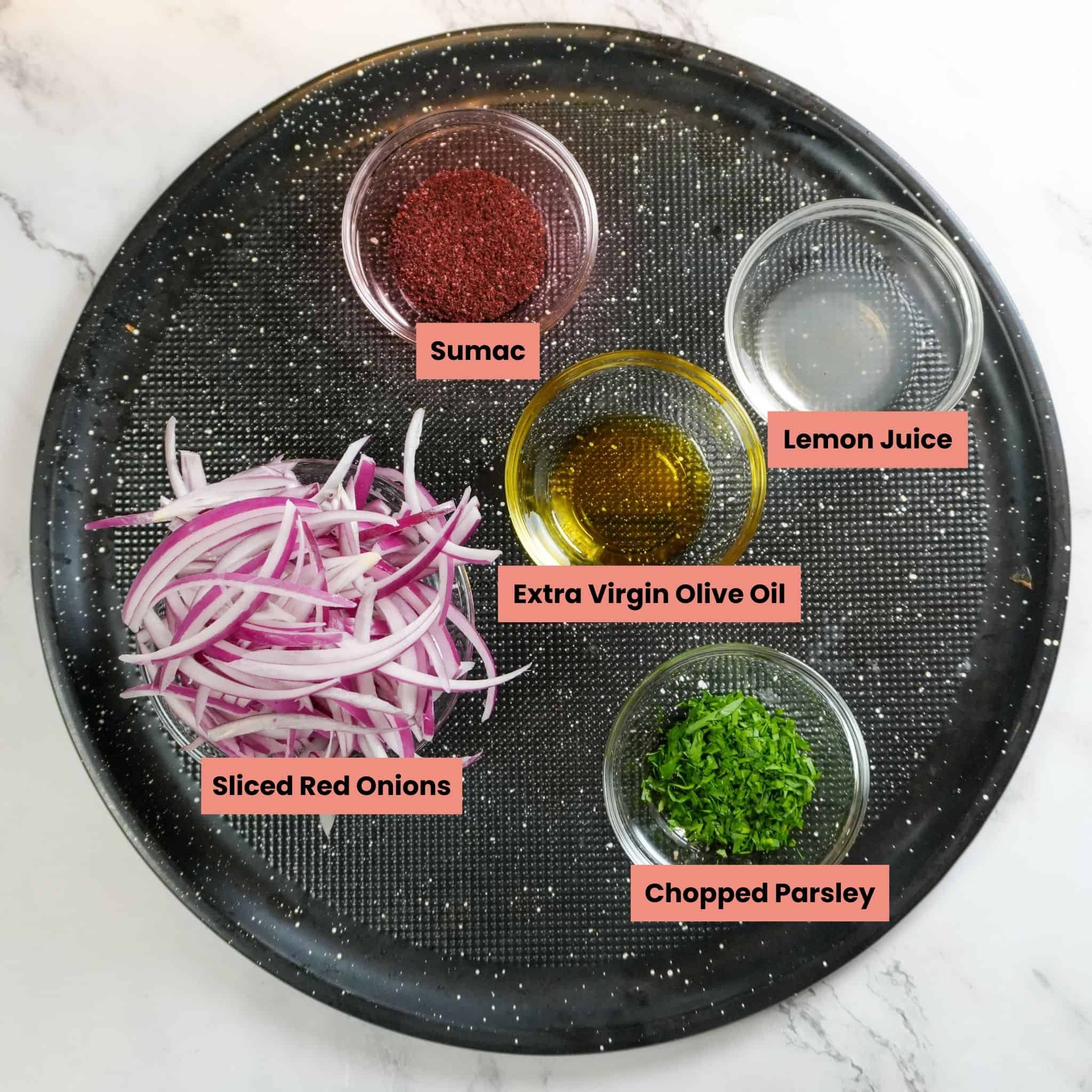
Instructions with Pictures
Follow the instructions and cooking tips below using the step-by-step picture guide.
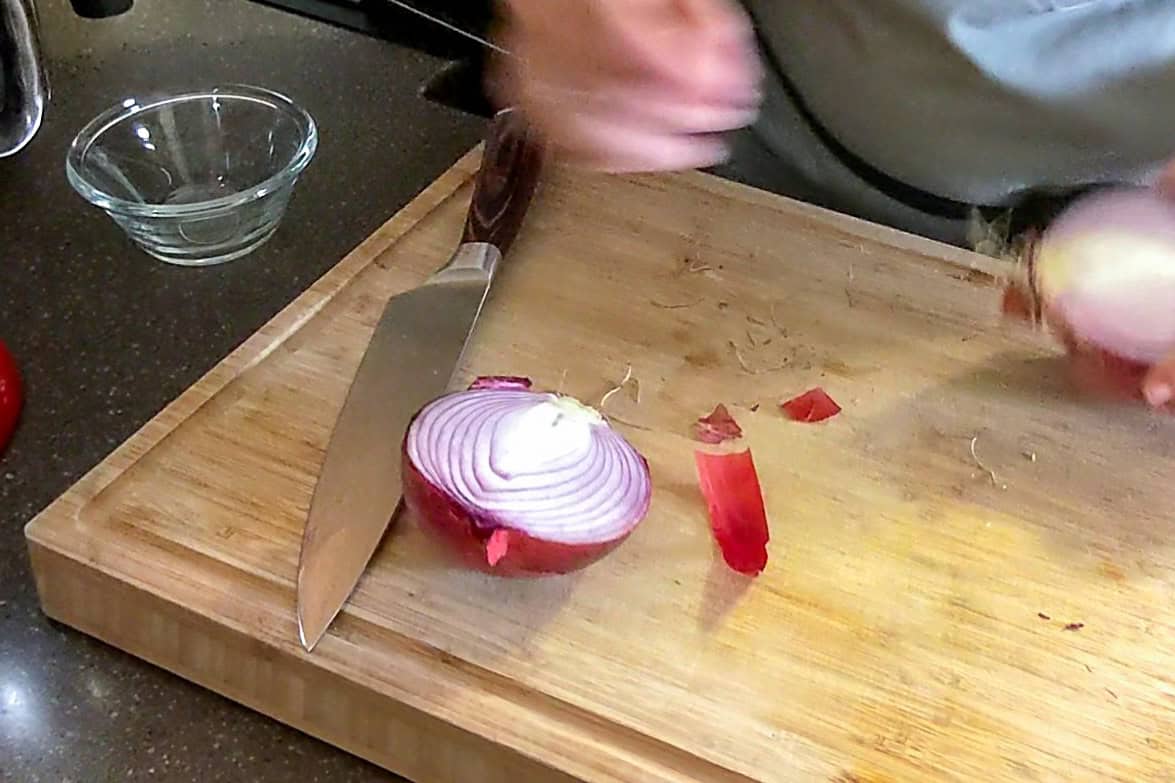
First, slice the onion in half with a sharp knife.
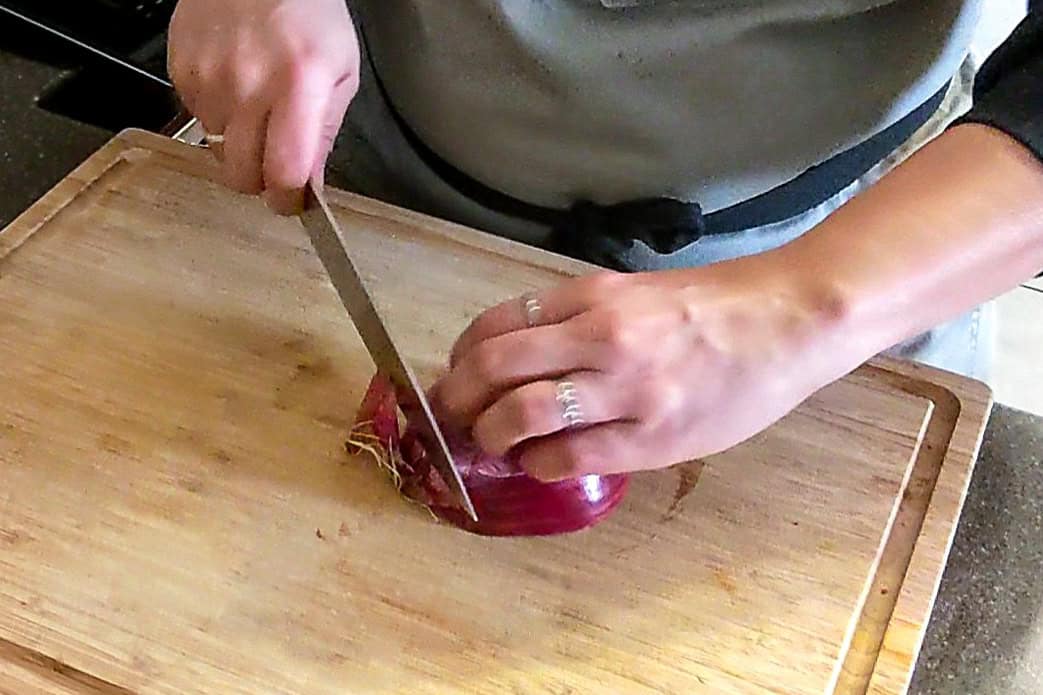
Then, remove the tips.
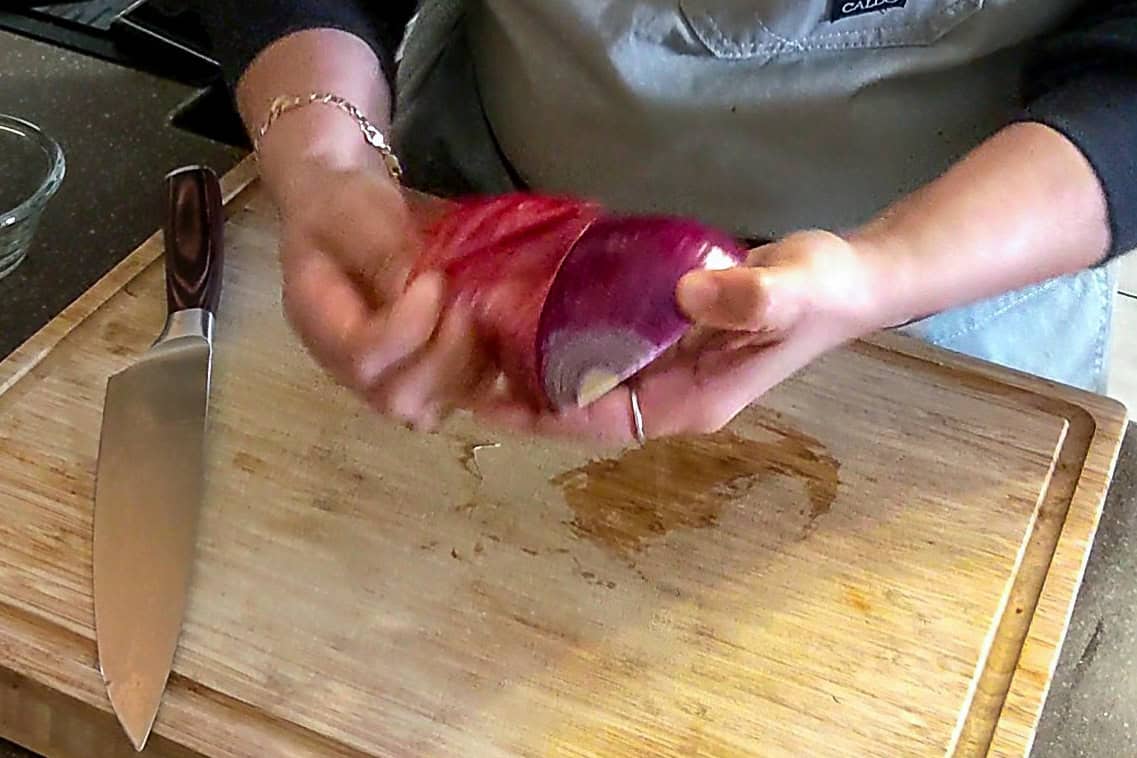
Remove the rough, papery layer from the onion.
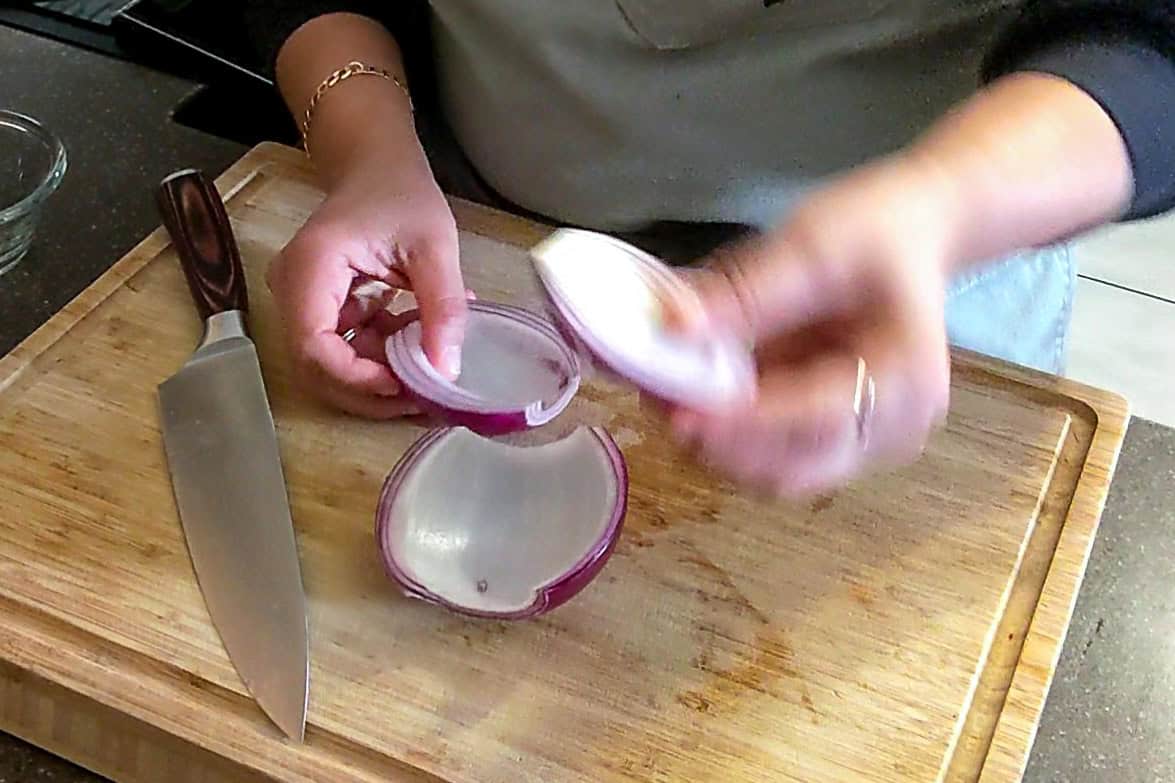
Then, remove it into separate layers (with at least three still attached).
Slice the Onion Facing Up
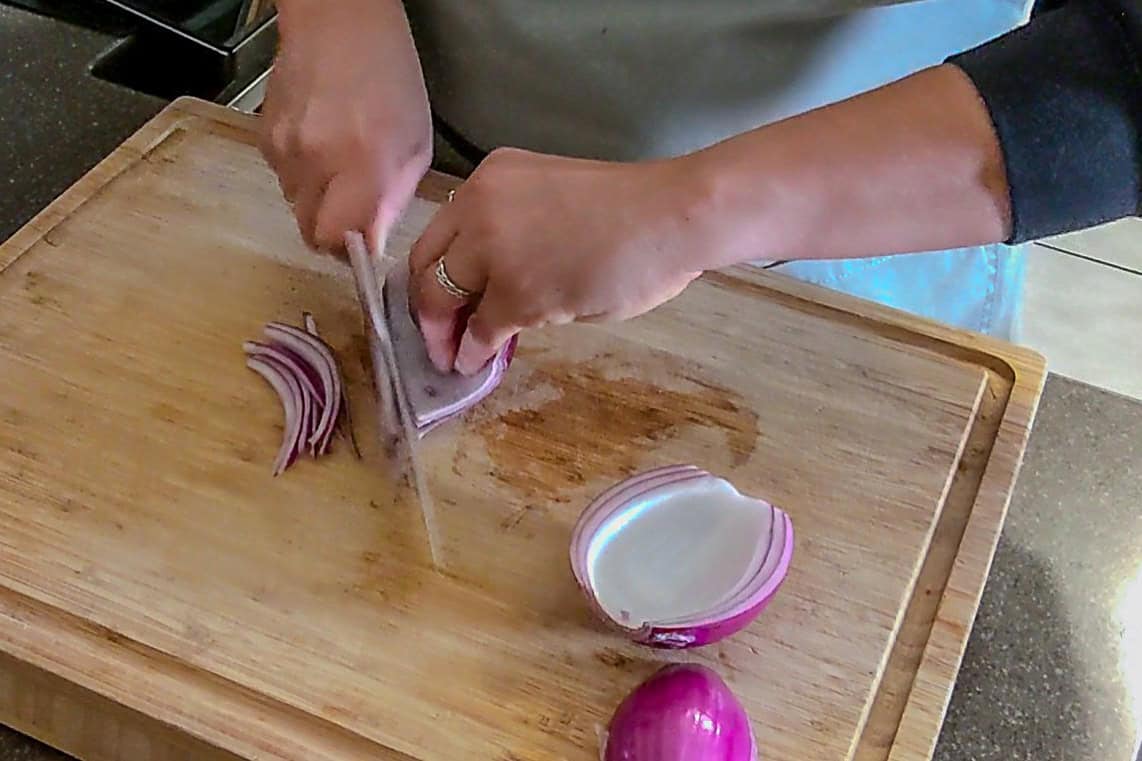
Thinly slice the red onion into thin, even slices and place them in a mixing bowl.
Chef Tip: For best results, use a sharp knife or a mandoline slicer to ensure uniform slices, which will help the onions absorb the seasonings evenly. If onions tend to make you tear up, chill them in the fridge for 10 minutes before slicing.
Or Facing Down
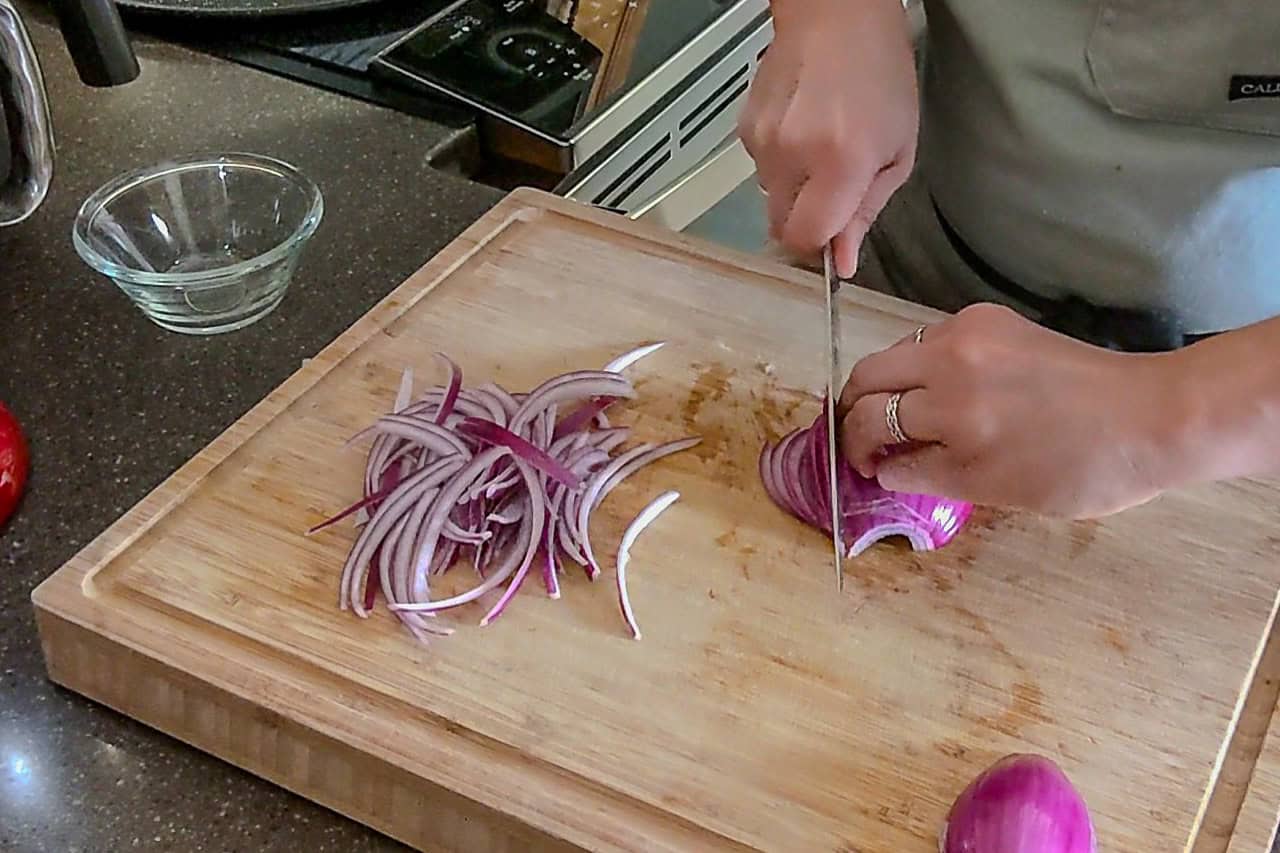
Soak the slices in cold water for a milder onion taste for 5–10 minutes before adding the seasonings.

I recommend using extra virgin olive oil since this salad is eaten raw to boost flavor.
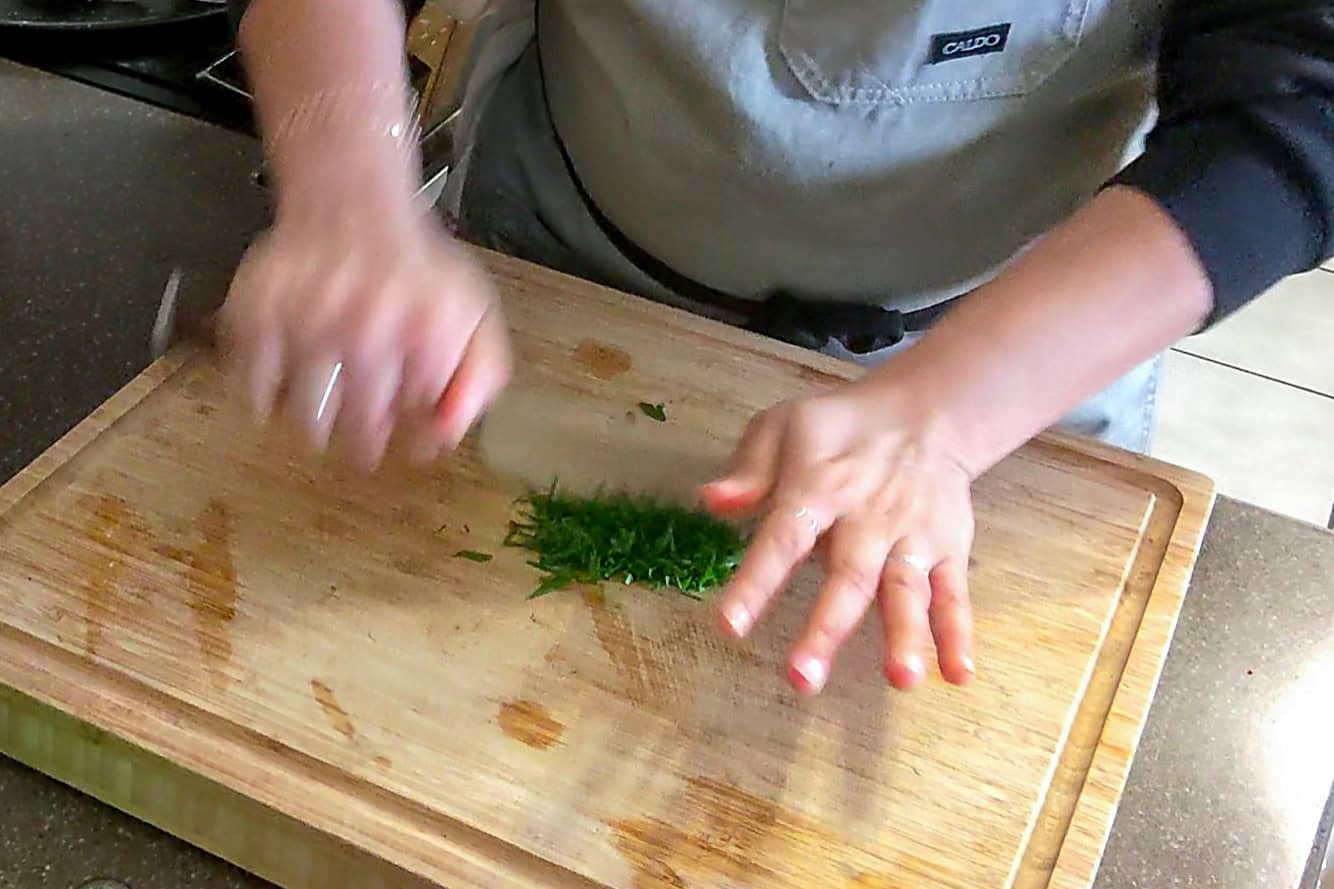
Using freshly chopped parsley for this salad not only gives a beautiful color but adds freshness to the flavor.
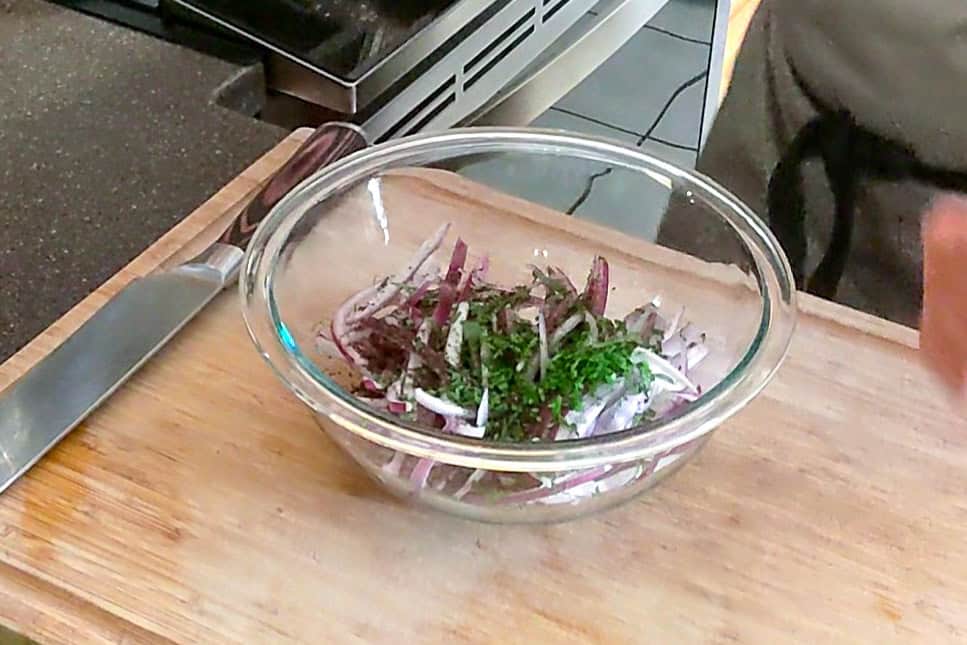
Sprinkle sumac powder, salt, lemon juice (or vinegar), and olive oil over the onion slices.
Chef Tip: If you want an extra punch of flavor, add a tiny pinch of sugar, honey, or pomegranate molasses—this helps balance the acidity and enhances the natural sweetness of the onions.
Now, toss everything together until the onions are evenly coated with the seasonings.
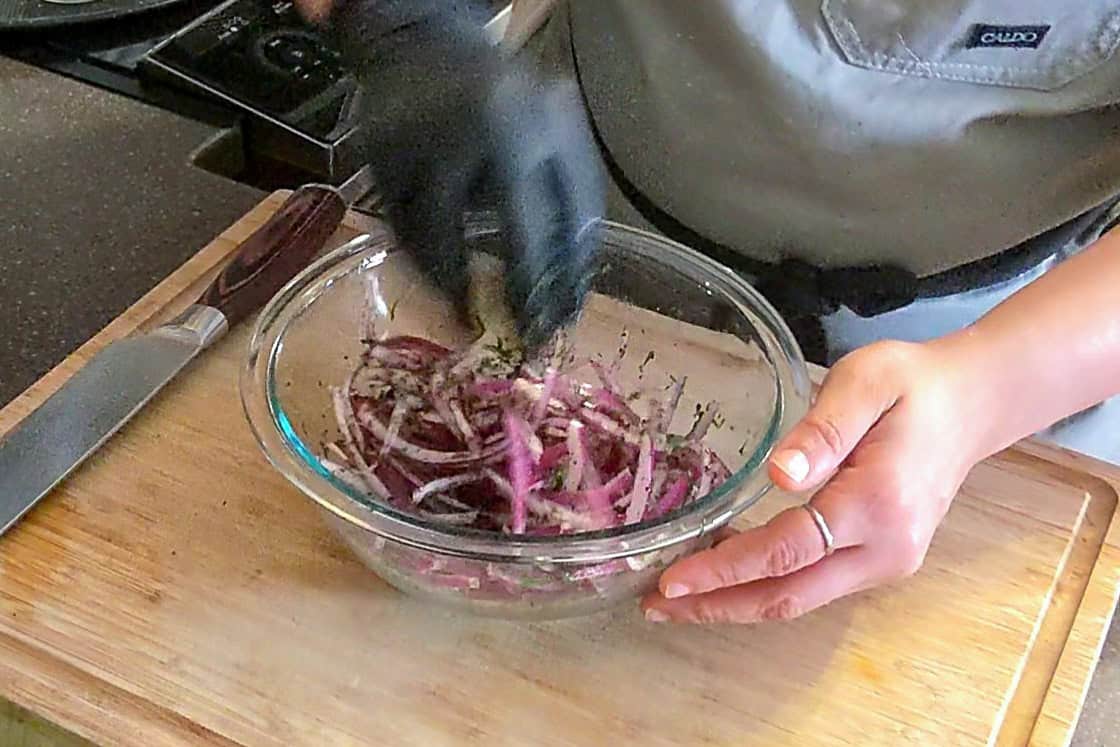
Use your hands or a pair of tongs to massage the onions while mixing gently. This helps break down the onion’s sharp bite, making it softer and more flavorful.

Allow the onions to sit for 10–15 minutes to soften and absorb the flavors.
Chef Tip: If you have extra time, letting them marinate for 30 minutes or longer will enhance the tangy, citrusy flavor even more.
Substitutions
Dairy-Free
- Yay! This recipe is naturally dairy-free.
Gluten-Free
- Bonus! This recipe is 100% gluten-free.
Vegetarian
- Triple Threat! this recipe is naturally vegan and a perfect accompaniment to plant-based meals.
Convenience
- Red Onion – Swap with white or yellow onion for a milder or slightly sweeter taste. Check the Variations section for more details.
- Sumac – For a similar citrusy tang, use lemon zest with a pinch of black pepper or try smoked paprika with a few drops of lemon juice for a warm, tart depth. While Sumac has a unique earthy brightness, these combos come close.
- Lemon Juice – Apple cider vinegar is the best substitute for its mild, fruity tang, while white vinegar offers a sharper acidity. If using vinegar, a tiny pinch of sugar helps balance the tartness.
- Olive Oil – Avocado oil is the closest match in texture and flavor, while vegetable or canola oil works in a pinch but lacks the richness. A few drops of toasted sesame oil can add a subtle, nutty twist.
- Fresh Parsley – Dried parsley is a quick alternative, though it lacks the freshness, while cilantro offers a more vibrant, herbaceous twist if you don’t mind a flavor shift.
Change Heat Level - Modify the recipe's heat level to your liking and learn more about the Scoville Scale and Chili Pairings.
Variations
Enhance your sumac onions with a touch of pomegranate molasses for sweet tanginess, white onions for a milder bite, and crushed garlic for a bold depth of flavor, transforming this simple condiment into a flavorful powerhouse perfect for grilled meats, shawarma, and mezze platters.
Add Pomegranate Molasses – A Sweet & Tangy Boost
A drizzle of pomegranate molasses enhances sumac onions with a deep, sweet tang that perfectly balances the acidity of sumac and lemon juice. Commonly used in Lebanese and Turkish cuisine, this secret ingredient boosts the onion flavor with a tangy twist.
Just a small drizzle mixed well is enough to add complexity, but be mindful—pomegranate molasses is highly concentrated, so a little goes a long way. If the mixture becomes too sweet, an extra squeeze of lemon juice restores its bright acidity.
Use White Onions – Mellow Out the Sharpness
No red onions? White onions work just as well, though they have a sharper bite. Soaking them in cold water for 10 minutes softens their intensity, making them just as ideal for sumac onions.
For an even milder flavor, adding a splash of apple cider or white vinegar to the soaking water helps remove some of the sulfur compounds responsible for their strong bite. After soaking, simply drain, pat dry, and mix with sumac, lemon juice, and olive oil for a perfectly balanced result.
Include Crushed Garlic – Amp Up the Flavor
For garlic lovers, adding crushed or minced garlic brings an extra punch of savory depth to sumac onions, making them an excellent pairing for grilled meats, shawarma, and mezze platters. Using just half of a small garlic clove, finely minced or crushed into a paste, is enough to infuse the onions with robust flavor.
Mixing it directly with the onions, sumac, and lemon juice creates an instant boost, but for a milder taste, letting the garlic sit in lemon juice for a few minutes before mixing can soften its intensity. If raw garlic is too strong, roasting or lightly sautéing it adds a sweeter, more mellow flavor to the dish.
Equipment
Sharp Knife
A sharp chef’s knife is essential for thin, even onion slices that absorb sumac and lemon juice effectively, ensuring a balanced flavor and texture. If you prefer an easier method, a mandoline slicer delivers ultra-thin cuts effortlessly—just use the hand guard for safety! Learn about the Japanese Mandoline.
For large batches, a food processor with a slicing attachment speeds up the process while maintaining uniformity.
Cutting Board
A sturdy cutting board keeps your workspace safe and mess-free while slicing onions. A board with a juice groove helps contain the onion’s natural juices, reducing cleanup. If you don’t have one, a large plate can work in a pinch, though it may be slippery, or a flexible silicone mat makes transferring onions to the bowl easy.
Mixing Bowl
A medium to large mixing bowl ensures the onions get evenly coated in sumac, lemon juice, and olive oil. For best results, add the onions first, then drizzle the seasonings over them. A large salad bowl or even a resealable bag works as an alternative—just seal and shake for a mess-free mix.
Tongs or Spoon
Using tongs or a spoon helps evenly distribute the seasoning while keeping your hands stain-free (sumac’s red pigment is no joke!). Gently toss the onions with upward motions and let them rest for 10–15 minutes to allow the flavors to meld. If you don’t mind getting a little messy, using your hands can help soften the onions further.
- My Rating: ⭐⭐⭐⭐⭐
- Purchased: 11/09/23
- Updated: 02/14/25
- My Review: The PAUDIN 8-inch Chef Knife is an absolute standout in both sharpness and craftsmanship. It stays incredibly sharp through regular use, making prep work effortless. The high-carbon stainless steel blade showcases PAUDIN’s attention to detail, while the ergonomic handle provides a comfortable grip for extended use. Despite its premium feel, this knife is impressively affordable, offering exceptional quality without the high price tag. That’s why I’ve recently switched all my knives to PAUDIN—they truly deliver on durability, beauty, and performance. If you want a reliable, well-crafted knife at a great value, this is the one to get!
Kitchen Must Haves - Find other tools I use here.
Storage
Refrigeration
To keep sumac onions fresh, store them in an airtight container or glass jar in the coldest part of the refrigerator. They stay crisp and flavorful for up to 3 days, but before serving, give them a quick toss to redistribute the sumac and lemon juice.
If they taste too tangy after refrigeration, let them sit at room temperature for 5 minutes to mellow out the acidity.
Freezing
While freezing sumac onions isn’t recommended due to the loss of texture, it can be done if necessary. To freeze, place them in a freezer-safe bag or airtight container, removing as much air as possible to prevent freezer burn. Store for up to 1 month, then thaw in the refrigerator overnight.
Keep in mind that frozen and thawed sumac onions will lose their crunch and are best used in cooked dishes like stews or grain bowls rather than as a fresh topping.
Reheating
Since sumac onions are meant to be enjoyed cold or at room temperature, reheating isn’t necessary. However, if you prefer them less chilled after refrigeration, let them sit at room temperature for 10–15 minutes before serving. If the acidity feels too strong, a drizzle of olive oil or a pinch of sugar can help balance the flavors.
Toss well before serving to ensure even seasoning, and enjoy them with shawarma, kebabs, wraps, salads, or mezze platters for the best taste and texture.
Airtight Food Containers - I interchange glass food storage containers with plastic clipping lids or wooden push-ins. I always suggest glass storage containers because they can be microwaved, they hold food without staining, and the glass keeps the food at a more stable temperature, keeping it fresher and longer.
Try the OXO Good Grips Smart Seal Glass Rectangle Food Storage Containers or the Pyrex Freshlock Glass Food Storage Containers.
Cooking Tips
Cook's Notebook is your Cooking Tips Resource Guide. Become a better home cook with tips to help you cook more efficiently.
- For milder onions, soak them in cold water for 10 minutes before seasoning.
- Let the onions sit for at least 10 minutes to allow the flavors to develop fully.
- Use fresh sumac for the best flavor, as older sumac can lose its tangy potency.
- Adjust acidity to taste—add more lemon juice if you like extra tang.
- Toss the onions right before serving to keep them fresh and crisp.
Frequently Asked Questions
Here, you will find a list of common questions that I have answered. If you have questions, please write them in the comment section below.
Yes! They taste even better after a few hours as the flavors meld together. Store in an airtight container in the refrigerator for up to 3 days.
If sumac is unavailable, substitute with a mix of lemon zest and a tiny pinch of smoked paprika for a similar tangy effect.
Yes, letting them sit with lemon juice and salt for 10–15 minutes is a great way to soften the bite.
Yes, but white onions tend to be sharper. To mellow the flavor, soak them in cold water for 10 minutes before seasoning.
They are great on shawarma, falafel, grilled chicken, kebabs, and Mediterranean grain bowls.
Middle Eastern Recipes
Looking for other Middle Eastern-inspired recipes like this? Try these:
- Beituti Chicken Shawarma Rice Bowl | Quick and Easy
- Air Fryer Chicken Shawarma | Quick with Beituti
- Quick Parsley Cucumber Tomato Feta Salad
- Creamy Lemon Greek Yogurt Dressing | Easy 5-Minute
Side Dish Recipes
Looking for other delicious side dish recipes like this? Try these:
- Quick & Easy Food Chopper Guacamole with Jalapeño Kick
- How to Make Multigrain Rice | Purple Rice Recipe
- Easy Oven Baked Pecorino Basil Pesto Corn on the Cob
- Easy Whipped Garlic Herb Cottage Cheese Spread
📖 Recipe
Simple Sumac Onions Recipe
Ingredients
- 1 large onion
- 1 tablespoon sumac
- 1 tablespoon lemon juice or white vinegar
- ¼ cup parsley chopped
- 1 tablespoon olive oil
- ½ teaspoon kosher salt
Equipment
Instructions
- Slice the Onion: Thinly slice the red onion and place it in a bowl.
- Add Seasoning: Sprinkle the sumac, salt, lemon juice, chopped parsley and olive oil over the onions.
- Mix Well: Toss everything together until the onions are evenly coated with the seasoning.
- Let it Rest: Allow the onions to sit for 10–15 minutes to soften and absorb the flavors.
- Serve: Use as a topping for grilled meats, salads, wraps, or falafel.
Video
Notes
Sweet White Onions (e.g., Vidalia or Maui Onions): These are the best choice if you're using white onions. They have a milder, sweeter flavor, which balances beautifully with the tanginess of the sumac and lemon juice.
Why Sweet White Onions Work Best:
Their natural sweetness mellows out the sharpness of raw onions.
They absorb flavors from the sumac and lemon juice more effectively without overpowering the dish.
Other Options (If Sweet White Onions Aren’t Available):
Standard White Onions: These are sharper and more pungent but can still work. Soak them in cold water for 10–15 minutes before seasoning to reduce the bite.
Spanish White Onions: Slightly milder than regular white onions, these are also a solid choice. Quick Tip: If using sharp white onions, adding an extra drizzle of olive oil and a pinch of sugar can help balance out their stronger flavor.
Nutrition
Subscribe to the YouTube Channel
SUBSCRIBE: 👈To my YouTube Channel to Get Notifications of New Videos.


Chef Maika Frederic
Chef and Educator
Haitian-American chef and educator Maika Frederic blends bold flavors with approachable recipes. With a background in both professional kitchens, classrooms, and children therapy—as a trained chef, former teacher and technician—she brings a thoughtful, inclusive touch to every dish. Through her platform, Just Maika Cooking, she shares diverse meals and practical tips to empower home cooks of all ages and levels.
Have a Comment or Question?
If you have a question or comment about this recipe, please post it below. You will definitely get a quick response. It also helps our other readers to stay informed. Thanks!

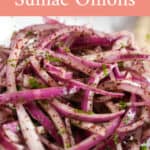

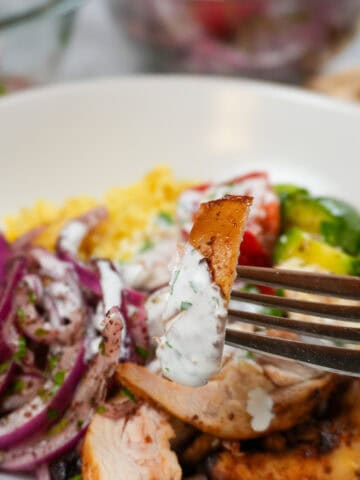

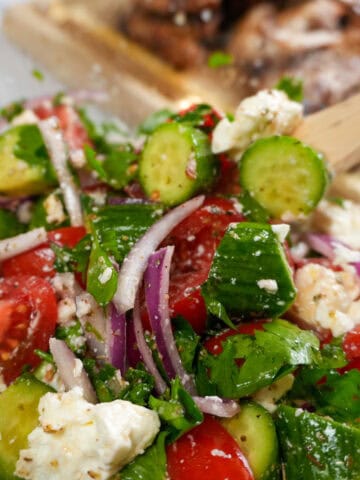

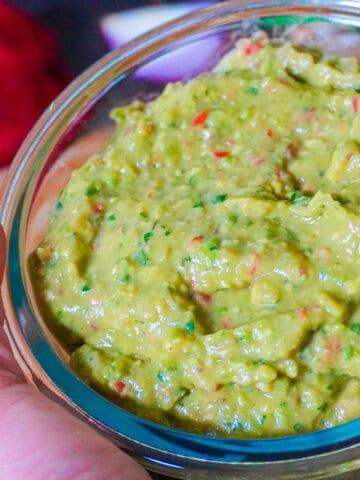
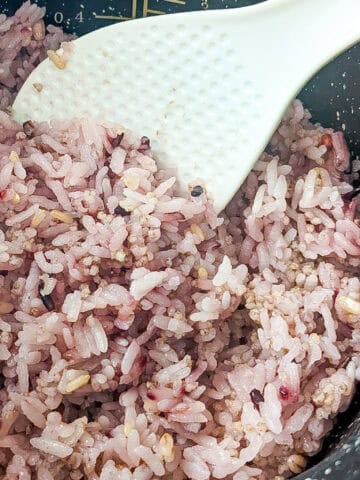



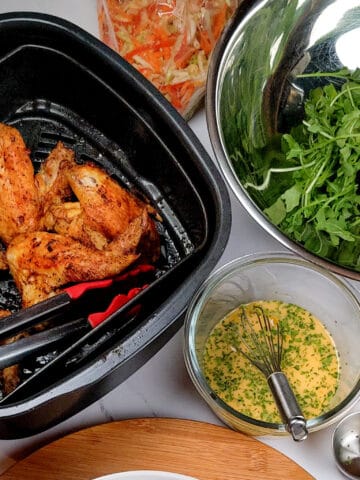


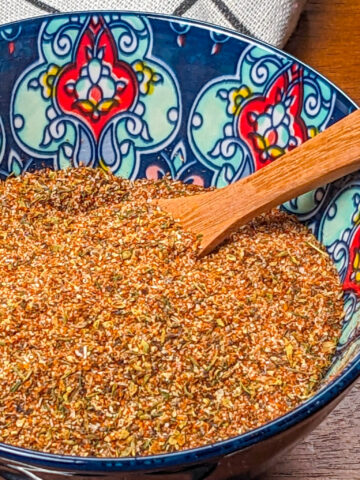
Leave a Reply